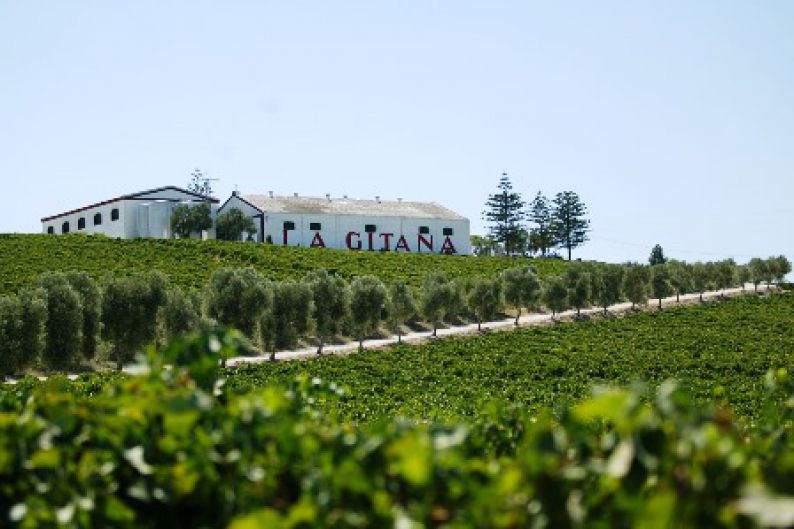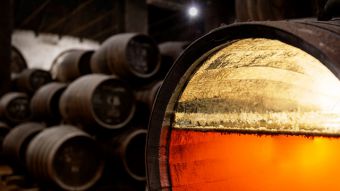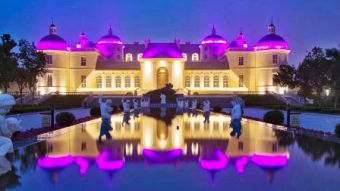HIDALGO LA GITANA. MANZANILLA AND SALT
Registered as “number 20”, this bodega situated in Sanlúcar de Barrameda is one of the oldest in the Jerez area. Dating back to 1792, it will soon be celebrating its 225th birthday. Its logo since 1900, a gypsy on a tambourine painted by the father of the great composer Joaquín Turina, has inspired the name of one of Sanlúcar’s great Manzanilla sherries and, recently, that of the bodega itself, whose registered name has officially been changed to Hidalgo La Gitana.
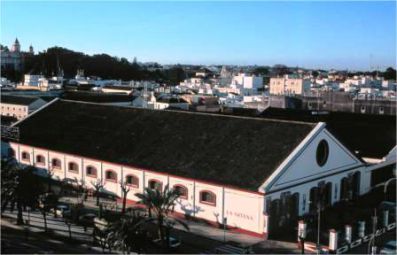 Early in the 18th century, there arrived in Sanlúcar de Barrameda, from the Valle de Castañeda in the province of Santander, one José Antonio Hidalgo. As part of the repopulation of the south by the north, a large number of montañeses, people from the Santander region, settled in the province of Cadiz. Hidalgo arrived to take charge of the running of a salt mine, an activity of prime importance due to the demand for this raw material which was essential for the preservation of food, among other things. In 1736, a son was born, Francisco Roque Pantaleón Hidalgo González, who married the daughter of a wine-producer by the name of Verjano, an important entrepreneur who had purchased some plots of land where the bodega is located, virtually on the banks of the river Guadalquivir. Not one building stood between these plots and the river (the panorama is markedly different today). When the father-in-law died, the son of the Hidalgo-Verjano union took charge of the business and founded the Bodega Hidalgo, registering the company name in 1792. They could now boast of making history - number 20 in the registry for the entire Jerez area.
Early in the 18th century, there arrived in Sanlúcar de Barrameda, from the Valle de Castañeda in the province of Santander, one José Antonio Hidalgo. As part of the repopulation of the south by the north, a large number of montañeses, people from the Santander region, settled in the province of Cadiz. Hidalgo arrived to take charge of the running of a salt mine, an activity of prime importance due to the demand for this raw material which was essential for the preservation of food, among other things. In 1736, a son was born, Francisco Roque Pantaleón Hidalgo González, who married the daughter of a wine-producer by the name of Verjano, an important entrepreneur who had purchased some plots of land where the bodega is located, virtually on the banks of the river Guadalquivir. Not one building stood between these plots and the river (the panorama is markedly different today). When the father-in-law died, the son of the Hidalgo-Verjano union took charge of the business and founded the Bodega Hidalgo, registering the company name in 1792. They could now boast of making history - number 20 in the registry for the entire Jerez area.
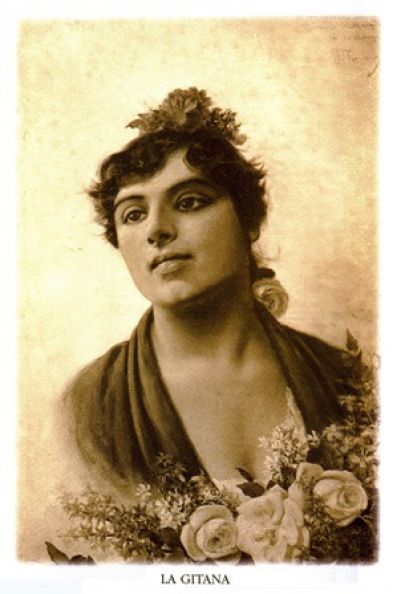 About a century later, in around 1890, the famous La Gitana trademark was created by the then direct descendent of the Hidalgo-Verjaon family, Eduardo Hidalgo. The birth of this trademark and logo, was a real masterstroke and veritable milestone in what we would today call ‘marketing’, but which had a far simpler motive at the time…. In the city of Malaga there was a wine store managed by a “beautiful and bold” gypsy woman. She sold a lot of Manzanilla from the Hidalgo’s Sanlúcar bodega, in bulk naturally, and which did not yet boast a proper brand name. Her Manzanilla started to become famous among the locals who called it “la manzanilla de la gitana”, the gypsy’s Manzanilla. Eduardo met this gypsy lady in person and she became a good friend. Such a good friend in fact that, a few years later, sometime around 1900, he asked another friend, the Sevillian painter Turina (father of the famous composer Joaquín Turina), to immortalise the señora in two portraits, one painted on a tambourine and the other on canvas. And thus was born one of the most well known emblems of Manzanilla sherry from Sanlúcar de Barrameda, in around 1900. Since then, the face of the gypsy who owned the Malaga wine store has become an intrinsic part of the Hidalgo family bodega’s identity. To such an extent that the registered company name, until relatively recently Vinícola Hidalgo, has now been changed to Hidalgo-La Gitana.
About a century later, in around 1890, the famous La Gitana trademark was created by the then direct descendent of the Hidalgo-Verjaon family, Eduardo Hidalgo. The birth of this trademark and logo, was a real masterstroke and veritable milestone in what we would today call ‘marketing’, but which had a far simpler motive at the time…. In the city of Malaga there was a wine store managed by a “beautiful and bold” gypsy woman. She sold a lot of Manzanilla from the Hidalgo’s Sanlúcar bodega, in bulk naturally, and which did not yet boast a proper brand name. Her Manzanilla started to become famous among the locals who called it “la manzanilla de la gitana”, the gypsy’s Manzanilla. Eduardo met this gypsy lady in person and she became a good friend. Such a good friend in fact that, a few years later, sometime around 1900, he asked another friend, the Sevillian painter Turina (father of the famous composer Joaquín Turina), to immortalise the señora in two portraits, one painted on a tambourine and the other on canvas. And thus was born one of the most well known emblems of Manzanilla sherry from Sanlúcar de Barrameda, in around 1900. Since then, the face of the gypsy who owned the Malaga wine store has become an intrinsic part of the Hidalgo family bodega’s identity. To such an extent that the registered company name, until relatively recently Vinícola Hidalgo, has now been changed to Hidalgo-La Gitana.
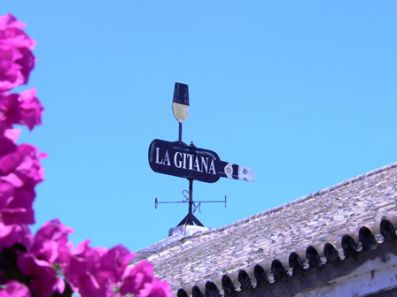
By the end of the 19th century, the bodega had become the biggest producer and indisputable market leader for Manzanilla sherry, and was able to indulge in the luxury of being rather exclusive. Between 1900 and 1960, the Jerez-based company, González Byass, bought a 25% stake in the winery, which was bought back some years later, in 1980, by Juan Luis Hidalgo, the bodega’s head honcho at the time. These were La Gitana’s and the bodega’s glory years and the company was struggling to keep up with demand. It therefore bought a large casco (building for maturing wines) known as La Arboledilla (the little copse), along with its stock of wine. La Arboledilla is the great cathedral of wine in the Jerez area and is believed to be the tallest winery in the world. It was built in 1835 and designed by a master builder, since no architect dared to construct it due to its enormous dimensions and great height. This building has had various owners throughout its perilous history and, at the end of the 1980’s/early 1990’s, it belonged to Marcos Eguizábal, the Rioja entrepreneur who was one of the major “casualties” of the 1983 expropriation of the Rumasa holding company by the Spanish government. For a cost of a thousand million pesetas (approximately 6 million euros), he sold this architectural jewel and all of its oenological contents to Vinícola Hidalgo (which in those days was the name of the company today known as Hidalgo-La Gitana). Fermín Hidalgo, the firm’s young sales director today, remembers receiving his first communion there in 1993.
A few years after the purchase of La Arboledilla, the “great strike” which affected the entire industry proved to be a major setback for the Hidalgo family, who, despite owning stock and bodegas, were unable to continue bottling and as a result lost their most important customers and exclusive sales contracts. They were forced to sell the great La Arboledilla cathedral, with its entire stock, to the Barbadillo company in the late 1990’s. From that time to the present day, the family-owned winery has managed to save the furniture, despite having to sell the property. After a major restructuring of the board of directors, the management team members have changed but not the family. The company continues to be run by the Hidalgos.
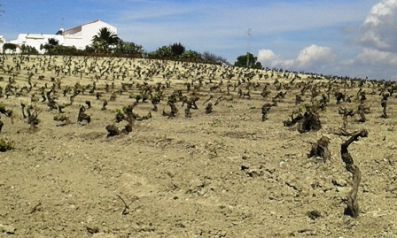 EL CUADRADO (THE SQUARE VINEYARD)
EL CUADRADO (THE SQUARE VINEYARD)
One of La Gitana’s little jewels is the El Cuadrado vineyard, situated between Sanlúcar de Barrameda and Jerez, in Balbaína Alta, one of the most sought-after vineyards for Finos and Manzanillas due to its excellent quality. Here, we can still find old vines that have survived the vicissitudes of recent years and which were there at the birth of many of the “old glories” much coveted today. At the time of writing, La Gitana and the company’s other outstanding Amontillados, Olorosos and Palo Cortados all come from its own vineyards. The company also owns and produces a highly prestigious Manzanilla Pasada called Pastrana. This is aged for much longer, has more “clases” (criaderas) and is an authentic “single vineyard” sherry made from grapes hailing from a vineyard located in the equally splendid Miraflores locality in Sanlúcar de Barrameda.
It is only right and proper that we end this brief history by mentioning a real innovation which the bodega has invested heavily in. They have developed a tap system allowing the famous La Gitana Manzanilla to be served ice-cold from the counter of high-end bars. This is quite a novelty and has resulted in a considerable increase in sales. As of today, 270 establishments offer La Gitana ‘on tap’. There is already one in operation in the United States, ten more are winging their way across the Atlantic, and Tokyo’s Sherry Club will boast its first La Gitana Manzanilla tap this autumn.
Given the Japanese’s passion for Sherry and Flamenco, its success is guaranteed. La Gitana discretely on tap... in the land of the rising sun.
